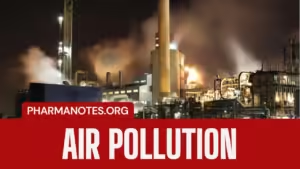Air Pollution

Intended Learning Outcomes
At the end of this session, students will be able to
• Explain Air Pollution
• Describe the source of Air pollution
• Discuss the effect of Air pollution
• Discuss control of Air pollution
Pollution – Definition
• Any undesirable change in physical, chemical or biological characteristics of air, land, water
• Pollution is the introduction of contaminants into an environment that causes instability, disorder, harm or discomfort to the ecosystem i.e. physical systems or living organisms
• Pollution can take the form of chemical substances or energy, such as noise, heat, or light
• Air pollution may be defined as any atmospheric condition in which certain substances are present in such concentrations that they can produce undesirable effects on man and his environment
• Air pollution is one of the most serious environmental problems in societies at all level of economic development
• The result can be lung disease, eye problems, and increased risk of cancer
Unit of measurement
• Concentrations of air pollutants are commonly expressed as the mass of pollutant per Unit volume of air mixture, as mg/m3, μg/m3, ng /m3
Types of pollutants
• CONVENTIONAL: Sulfur Dioxide, Nitric oxide (NO), Nitrogen dioxide (NO2), Hydrocarbons, Lead Etc
• NON-CONVENTIONAL: Asbestosis (lung scaring), Mesothelioma (cancer of the lung and the abdominal lining), Mercury (Lung cancer), Beryllium, Copper, Super phosphate, Glass and enamel factories, Aluminum plants, Hydrogen, Lameness.
Air Pollution
|
How |
Why |
|
A cloud of smoke from the exhaust of a vehicle |
Increasing traffic |
|
Smoke from a factory chimney |
Industrialization |
|
Eruption of a volcano |
Rapid economic development |
|
Cigarette smoke |
Growing cities |
|
Burning leaves |
Apathetic people |
Effects of Air Pollution
• Health problems
• Damage to the environment
• Damage to property
• Thinning of the protective ozone layer of the atmosphere which is leading to climate changes
Air Pollutants and its impact on human health
Particulate Matter
• Dust and smoke particles cause irritation of the respiratory tract and produce bronchitis, asthma and lung diseases.
• Dust and smoke function as nuclei for condensation of water vapors and produce smog which attract chemicals like SO2, H2S, NO2,etc.
• Smog not only reduce visibility but is also harmful due to its contained chemicals.
Carbon Monoxide
• It is formed by incomplete combustion of carbon fuels in various industries, motor vehicles, etc
• It causes impairment of judgment and vision, headache and dizziness
Sulphur Dioxide
• It is produced in large quantity during smelting of metallic ores.
• It causes tracheal irritation, cough, bronchial spasms.
Chlorine
• It is present in volcanic eruptions and emitted in processes involving use of chlorinated chemicals
• It causes eye and respiratory ailments
• Chlorine rising up in the atmosphere poses danger to ozone layer
Smog
• Smog is the combination of smoke and fog. It is a man-made air pollutant in urban areas.
• The term smog was coined by H.A.Des Voeux
• Industrial Smog –“London” Smog
“London” smog: fog soot particles Sulfur Dioxidetar. This forms a highly acidic mist.
• Some incidents of deaths associated with sulfurous smog:
1930- Meuse Valley, Belgium- 63
1948- Donora, Pennsylvania -20
1952 -London (5 days)- 4000
1962 -London -700
These deaths lead to a reduction in coal consumption and an increase in alternative fuels, such as gasoline…
Air Pollution Solutions
• Encourage your family to walk more
• Take the school bus
• Reduce the amount of spray bottles
• Do not burn leaves in your yard- put them in a compost
• Keep your family cars in tune
• Put catalytic converters on cars
• Share your room with others when the air conditioner is on
• Take care of your trees
Summary
• Any undesirable change in physical, chemical or biological characteristics of air, land, water is pollution
• Smog is the combination of smoke and fog
• A disease of the lungs characterized by fibrosis and caused by the chronic inhalation of mineral dusts, especially silica and asbestos is Pneumoconiosis
Also, Visit:
B. Pharma Notes | B. Pharma Notes | Study material Bachelor of Pharmacy pdf